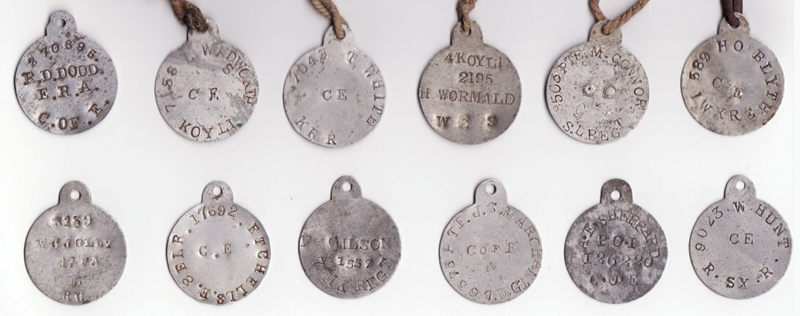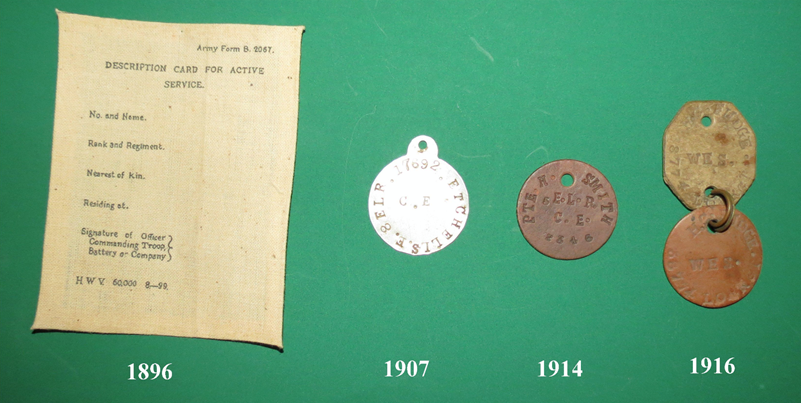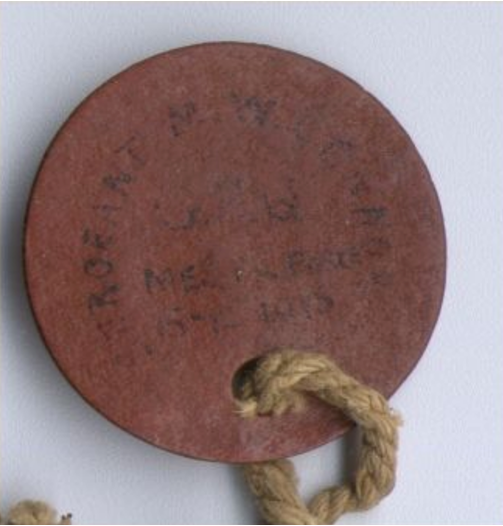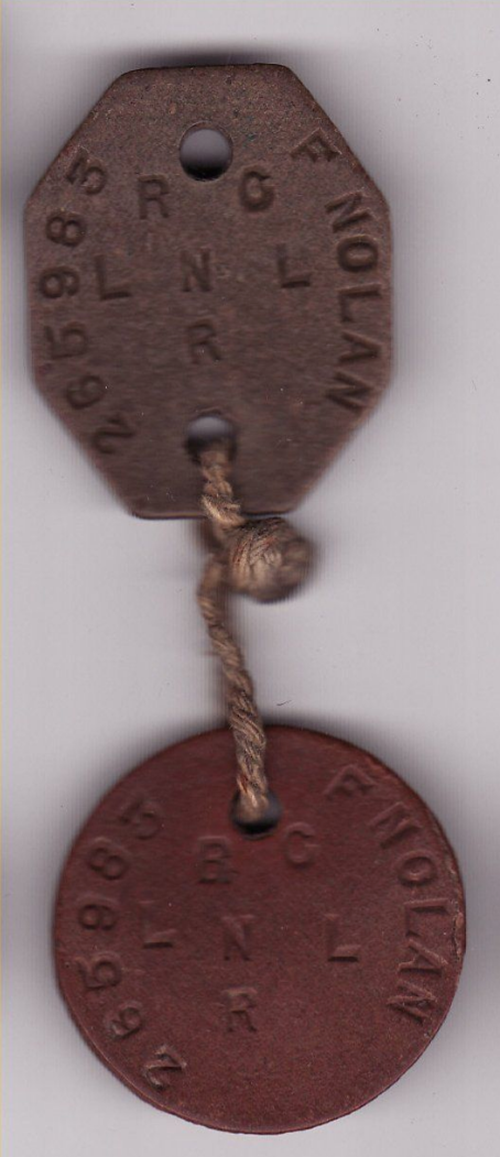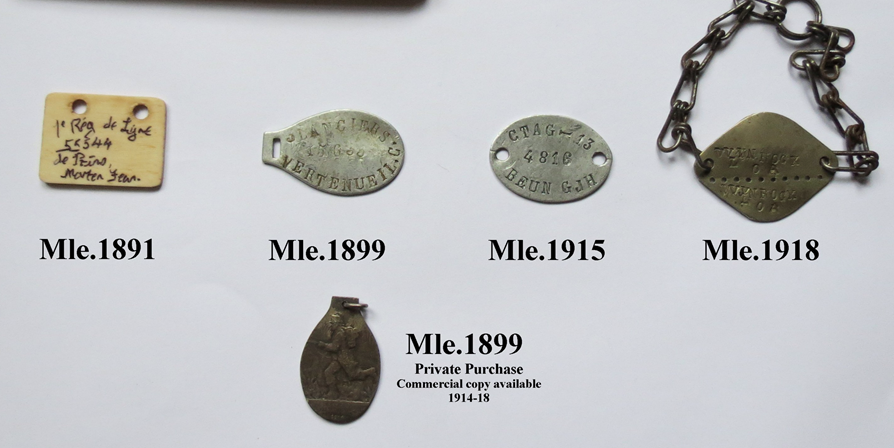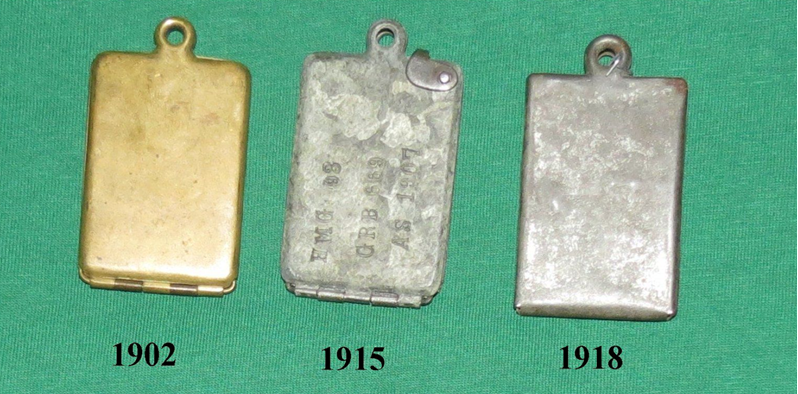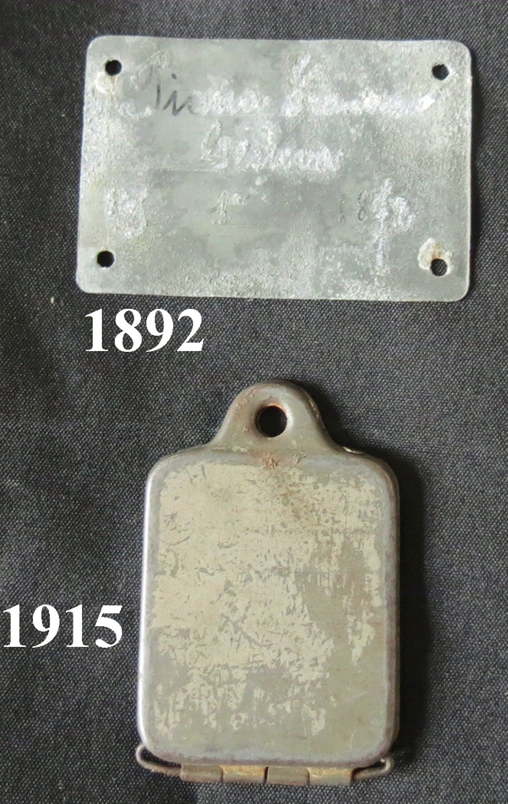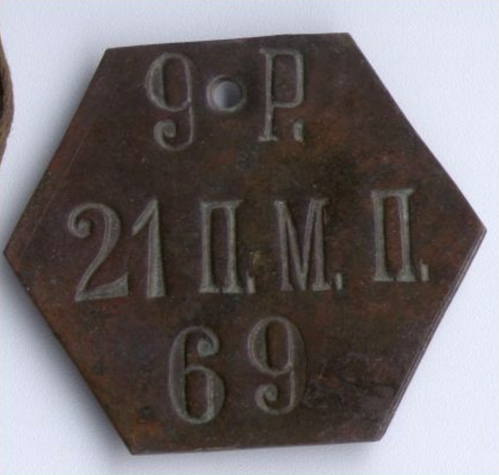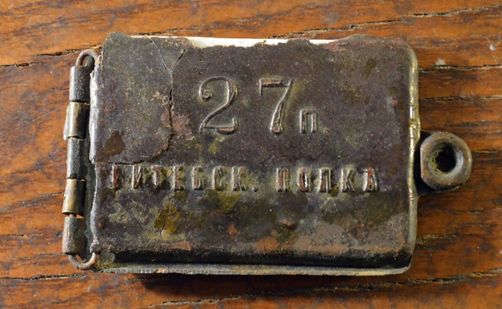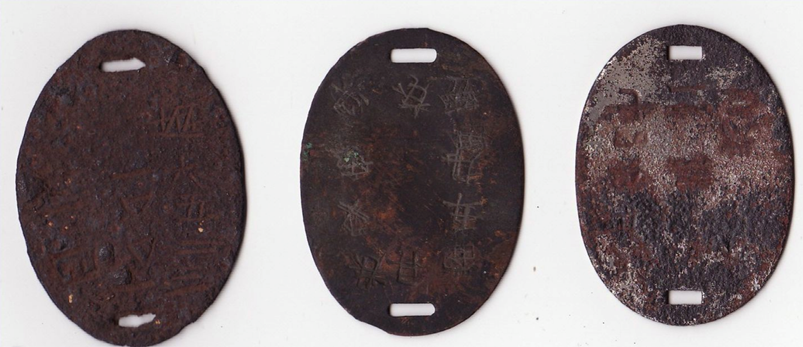Identifying the Dead: a Short Study of the Identification Tags of 1914-1918
- Home
- World War I Articles
- Identifying the Dead: a Short Study of the Identification Tags of 1914-1918
Introduction to Identification Discs and Tags of the First World War
|
Perhaps one of the most personal of all issue items to be carried by the majority of soldiers of the Great War, yet they appear to be one of the most understudied and neglected also. Maybe they’re not as “pretty” as a medal, but they are just as researchable (if not more so because of the information that they contain). They also have the added poignancy of the fact that they were “there” through all the trials and tribulations of the original owner …even, on occasion, staying with him up until (and after) his death… Nothing can hit home harder than thinking about the feelings of some anonymous soldier’s wife as she receives the blood-stained tags that were worn by her recently departed husband. They might only rarely receive pride of place above some mantle (more likely, they’ve been lost in some drawer bottom or pocket…or even binned without the blinking of an eye), but this seems to be the place reserved for the “shiny” mementoes such as badges and medals…no-one seems to want to see a framed disc of ugly red fibre or some cheap looking alloy. Whereby a medal (always issued after an event, sometimes never even having been seen or touched by the “recipient”) could, I suppose, be classified as a “memento”, the tag was actually there at the event and can sometimes be the only tangible link to the actual person who wore it. Though some form of identification (other than details written on equipment and uniforms) was carried by many soldiers for centuries (covering everything from paper labels to carved stones and pieces of wood), the Great War was the first war in which the majority of belligerents were officially issued with and wore these tags or discs continuously. However, it may be prudent to begin with a listing of dates and events that were significant to their development pre-1914… |
|
• 1862 – In May, John Kennedy from New York proposed that each Union soldier is issued with an ID tag. The motion was rejected, but many soldiers of both sides provide their own or purchase them from Sutlers (many of these can be extremely ornate and detailed) • 1864 – Following the German-Danish War, a Berlin master-craftsman proposed the issue of a “Hundesmarke” (literally “Dog tag”) named after the existing dog-tax tag but this was all but rejected by the Prussian War Ministry (and also gave birth to the story of Koenig Wilhelm flying into a rage about the unsubtle naming of the tag (“my soldiers are not dogs!”). Whether or not this is true, the name “Hundesmarke” was certainly forbidden in later years…which only served, of course, to encourage it’s use by the soldiers who wore them!). • 1866 – Some Prussian units were issued with such a tag – a small, iron rectangular plate marked up with unit detail - as a trial (unsubstantiated), but many (most?) were discarded by the troops in a superstitious fear of death. Some 8 months after the Battle of Koniggratz (Sadowa) of 3rd July 1866, the identity of approx 1,500 soldiers (out of 2,200 Prussian dead) had not yet been established forcing another push for the establishment to issue some form of Army-wide identity tag. • 1868 – A book entitled “Das Preussische Militar-Sanitatswesen und seine Reform nach der Kriegserfahrung von 1866” by the Royal Prussian Surgeon-General, Dr.Loeffler mentions the possible uses of a metal identity tag in the treatment of wounded soldiers (along with the uses of being able to positively identify battlefield dead). This work was highly influential and was taken into account the following year. • 1869 – Article 110 of the Prussian regulations of the Army Medical Services in the Field dated 29th April 1869 finally stated that an issued sheet metal tag was to be worn around the neck, suspended by a leather cord , upon which the soldiers serial number and unit was to be inscribed. This, according the article, was “…in order to positively establish the identity of soldiers killed on the battlefield or found unconscious...”. • 1870 - The first ever issue of an official identity tag ( the Recognoscirungsmarke – “recognition tag”) is to the combatant troops of the German Armies of Prussia, the North German Confederation and their allies upon mobilization for the invasion of France (some 883,000 combatants (only 470,000 of whom were “Prussian”) out of a total mobilisation strength of 1,183,000) • 1878 – On 10th April of this year, Article 26 of the German Wartime Medical Regulations stated the necessity of an Army-wide tag to be issued to all troops, even those of non-combatant units. |
|
Many countries followed Germany’s example in the following years – France in 1881, Belgium in 1891 and Italy in 1892 being, perhaps, the earliest. Most other nations didn’t follow suite until the early 20th Century – Austria and Russia in 1902 (though some Russian studies claim an introduction as far back as 1877), Britain in 1907 (though they did have a waterproofed “description card” in a pocket inside the tunic from the 1890s) and USA in 1906 etc. Many soldiers had “private purchase” tags and bracelets made for themselves prior (and post) these official issues however (a subject which is highly worthy of its own separate study). During the First World War, it is interesting to note that a huge quantity of these bracelets actually utilised blank discs that were on official issue to other nations (the French Mle.1881 seeming to be especially popular with British and US. |
|
|
|
Great Britain and Empire 1914-18 |
|
Prior to the introduction of the Identity Disc in British military service, soldiers were issued with a pre-printed glazed white calico ‘Description Card for Active Service’. Officially designated the ‘Army Form B.2067’ (AFB 2067), this card was intended to be filled in by hand and sewn into the inside of the tunic. First seeing issue in the Sudan in the late 1890’s, this was also the main means of identification carried throughout the Boer War (during this war a supplementary card could also be encountered – especially in Commonwealth and Empire Forces. Similar to the Description Card, this ‘Identity Card’ was issued on a regimental basis and carried the soldier’s details plus bi-lingual instructions in English and Dutch on what to do should the bearer of the card be killed or wounded.
The first British “Disc, Identity” was introduced by Army Order 9 of January 1907 (after being pattern approved on 29th August 1906). This order stated that “An identity disc (aluminium), fitted with a cord (42 inches in length) was to be worn around the neck and underneath the clothing” It also gave instructions in the stamping of these discs in that stampings were to be carried out by “Stamps, steel, for metal 1/8th inch” and that information carried should be the soldier’s number, rank, name, regiment and religious denomination. Upon a change in rank, a new disc was to be issued. These discs were stamped from thin aluminium sheet and measured approximately 35mm in diameter with an 8mm “tab”. Prior to the outbreak of war, there were at least three changes to the stamping and issue of Identity Discs… |
|
AO 102 of May 1907 introduced some slight changes to issue of the discs and dropped the stamping of ranks on them. AO 83 of April 1908 mentioned the issue of discs for special reservists. AO 38 of February 1909 confirmed the issue to the Territorial Force Religious denomination stampings on Territorial Force discs (only) were also dropped soon afterwards (though this was rarely adhered to) |
|
With the outbreak of war on 4th August 1914, it was realised that it would be practically impossible to keep up with the demand for aluminium discs and so, following on from a pattern approval on 21st August 1914 , a new disc that would become so familiar over the next half century was introduced. The new disc was a round disc made of red/brown vulcanised asbestos fibre approximately 35mm in diameter. Stamping regulations were as per AO102 of 1907. Though the new disc was now being issued, stockpiles of the aluminium discs were also being issued and so, it isn’t uncommon to encounter aluminium discs marked up to soldiers who didn’t enlist until 1915. |
|
Even though a new disc was now being issued, most soldiers were still only issued with one. This led to many post-mortem problems in the identification of the dead in that the one disc was being removed (as was regulation) for administrative purposes, leaving the body devoid of identification. The majority of soldiers acquired “private purchase” discs (usually in the form of a bracelet) and others obtained a second issue disc (on rare occasions, a blank disc can be encountered that, due to the unavailability of stamp sets, the details have been written in ink – a problem that was so widespread during the first quarter of 1915 that an Army Order was issued - AO 206 of 20th May 1915 – that expressly forbade this practice and invited the commanding officers of regular units to have their attention drawn to Appendix VIII of Clothing Regulations Part 1 and ,their Territorial counterparts, to paragraph 506F of the Territorial Force Regulations regarding the stamping of discs using 1/8in stamps).
Though extremely widespread, these second discs were still unofficial and it wasn’t until after the Directorate of the Commission of Graves registration and Enquiries suggested (following the French example of the previous year) the issue of a second identity disc in May 1916 and the eventual issue of Army Order 287 of September 1916 that the British Army heeded to the necessity of issuing a disc that was to remain on a body after death for future identification. The second disc was also of vulcanised asbestos fibre, but was manufactured in a green/brown shade and was an “octagonal – lozenge” in shape approximately 35mm by 30mm in size. This disc, in Army parlance, now became “Disc, identity, No.1, green”, with the original (1914) disc becoming “Disc, Identity, No.2, red”. The No.1 disc was to be attached to the long cord around the neck, with the No.2 being threaded on a 6 inch cord from this disc. No.1 was intended to remain on the body whereas the No.2 was to be removed for administration. Stampings on this new disc were similar to previous issues. The 2nd November 1916 saw this disc finally on general issue within the BEF (GRO 1922), though soldiers located in the UK would have received this discs earlier in preparation for overseas service. Although there were further issues of discs for equipment marking, etc from 1917 (plus a further General Routine Order (2661) on 30th September 1917 giving further instruction on the wearing of discs), the “official” British identity disc evolution during the war was now complete. There was no further change in discs until 1920 and, therefore, outside the scope of this study. RN discs generally followed suite with the Army discs. |
|
Canada |
|
Apart from the official issue of an “emergency pattern” disc in August 1914 (a large aluminium disc), Canadian discs, stamping patterns apart, followed the British style. By November 1916, the Canadian 1914 pattern disc had pretty much been superseded completely by the British patterns |
|
Australia, India, New Zealand and South Africa |
|
Australia and India followed the British patterns completely, but the 1907 disc appears to have been issued for far longer than in the British Army. Many discs issued as late as 1917 can be encountered stamped with Australian or Indian army detail. High quality 1907 discs (quite often engraved rather than stamped) are also found. Made of double thickness, these have the Australian coat-of arms stamped on the reverse. As far as can be ascertained, these may possibly be “souvenir” or privately funded tags rather than standard issue items. Interestingly, the AIF discs encountered appear to have a higher percentage of “1907/1916 pairs” than in any other force. New Zealand and South Africa both followed the British pattern from the issue of the Asbestos vulcanised fibre discs in 1914 (apart from the “NZ” and “SA” stampings in large letters that appears on the majority of these issues), but both nations also issued their own patterns initially – both of similar design to the Canadian emergency tag (but, in this case, they can also be encountered as having been manufactured out of thin, pressed steel). |
|
|
|
Germany …'Erkennungsmarken' As has been detailed in the opening section of this book, Germany (more specifically Baden, Bavaria and the nations of the North German Confederation) was the first country to officially issue identity discs to its soldiers on a wide scale during the Franco-German War of 1870-71. This first disc (the 1869 pattern ‘Recognoscirungsmarke’), introduced in April 1869 and first issued in July 1870, was a pressed steel rectangle approximately 4cm by 3 cm in size. This disc always had rolled edges and certain regimental details pre-stamped during manufacture. The number of the regiment, along with company and personal numbers were hand-stamped upon issue and only issued during war-time (therefore there was only ever one issue of this disc before it was superseded in 1878…however – see the note regarding these discs at the end of this chapter). On 10th January 1878, as a response to the increased size of the German Army in the potential time of war (and the April 1878 directive to issue discs to non-combatant troops), the 1869 pattern disc was replaced by a disc of far simpler manufacture. Prior to this, however, on 17th March 1875, the kingdom of Bavaria issued a slightly simplified pattern of the 1869 disc to her troops. This disc was a simple steel or zinc alloy rectangle of similar (though very slightly larger) dimensions to the disc of 1869. On this disc, however, there was no rolled edge and only one cord hole. Not all were ‘back-stamped’ with regimental detail, but many actually did still have this feature. The initial issue disc of 1878 (the Erkennungsmarke ) utilised surplus Bavarian 1875 pattern discs, but, of course, there were never enough produced to be issued to the entire German military (though examples could still be encountered on issue as late as 1914/15). Subsequent issues of the 1878 disc (issued, at first, alongside the 1875 pattern as a supplementary or replacement pattern disc) were even simpler – a small zinc alloy oval which was issued blank (all detail was stamped at regimental level). Information carried upon these discs was also of the same nature as the previous issue (with the exception of Bavarian discs, whose regimental details still usually began with ‘B’ ‘Bayr.’ or ‘Bay.’) but no longer carried national/state designation (though the neck cords were usually manufactured in state colours – see note at the end of this section regarding these cords). This was the disc that German soldiers were still wearing upon the outbreak of war in August 1914 after which a myriad of different shapes, sizes and styles of this disc could be encountered (round (though this is actually quite rare and could possibly be a German ‘emergency’ pattern), rectangular, one cord hole, two cord holes, elongated, stamped, inscribed, different details included, manufactured from different metals, etc., etc.) Possibly due to the huge size of the German Army in the field, it was becoming clear that, (along with the difficulties of identifying dead and wounded soldiers purely from the details on the 1878 tags (whereby a certain amount of cross-referencing with records would be necessary)) tags were having to be re-issued at an increasing rate due to regimental or even company transfers. It was therefore decided, in September 1915 (following on from Regulation 72822-V-B1 of the Prussian War Ministry issued on 13th August 1915 which, in turn, followed on from a proposal by the Prussian and Bavarian high command on June 16th 1915*), to issue a larger pattern disc upon which it would be possible to include more personal detail (preventing the need for as much record checking) and also have room to strike out old unit details and replace them with the new. |
|
(* the discs proposed in June 1915 were rectangular in shape, approximately 7cm by 5.5cm in size and contained the same detail as the 1878 disc but with the addition of the soldiers name. Never actually on official issue, a large number of these discs were manufactured and trialled, however, mainly seeing service on the Eastern Front.) |
|
These new discs were still oval, but now measured approximately 7cm by 5cm and contained the soldier’s name, date of birth and home town details along with his regimental details. From this point, recruit unit details may also be found (located on the obverse of the disc), but these were sometimes blanked out by the time the soldier was allocated to his active service unit. Details of the soldier’s present and previous units may also be found (officially blanked or “lined out” following subsequent transfers) on the reverse. Even after the issue of the 1915 disc, there remained the problem of post-mortem identification of soldiers. Upon death, the identity disc was removed for records, leaving the body with no identification. Even though it would be known that the particular soldier was dead, if the body was not able to be recovered until later (for whatever reason), there would be no way, especially if discovered by a different unit, that identification could be given to the corpse. The first attempts at solving this problem was done at a regimental/company level by stamping the identical details onto a 1915 disc twice, separated by a score mark. The intention of this was to break the disc in half, taking half (with full details) for records and leaving the other half (also with full details) on the body should the need for future identification arise. As may be imagined, this stop-gap solution was far from ideal as it could be difficult to break the disc by hand and, even if that was accomplished; a straight break was even more difficult. Therefore, in November 1916 (Prussian War ministry regulation 1727/8 16B of 16th November 1916), a new pattern disc was introduced in which the “split line” was stamped into the disc upon manufacture. This 1916 disc (though there was a very slight change to these discs proposed in a War ministry communiqué dated 16th September 1917* (2377/8.17 B3 Nr 903) which suggested slight sizing changes and also a change to the spacings of perforations, enabling a stronger construction to the disc. An extra hole to facilitate the gathering of numerous ‘break-off’ portions was also added – though this feature can also be found on some 1916 pattern discs too) was to see the German Army throughout the remainder of the war (though all other patterns can also be encountered to the very end) and, with slight alterations (such as personal detail being dropped in 1926), throughout the Second World War also. The legacy of this pattern disc still survives in many of the modern armies today. Dimension-wise, the 1916 disc was pretty much identical to the 1915 disc. Similar detail was contained either side of the serration and, again, subsequent unit detail may also be found on the reverse. As with all German discs, much variety in shape, size and material can be encountered, but the 1916 disc appears to have been the most “standardised” of them all. |
|
(* this “1917 Pattern” disc is not recognised by many collectors and historians as a separate pattern possibly because its issue was never officially regulated. Some manufacturers did, however, produce discs to the specifications suggested in 1917 and so, though, not really a radical pattern change, they do exist as a separate entity to the disc of 1916) |
|
The Kaiserlichemarine (Navy) pattern discs followed suite with the army, but the 1878 disc appears to be the most commonly encountered pattern… occasionally bearing the name of the ship upon which the original owner served. ‘Private purchase’ discs in the German armies, unlike those encountered in the armies of most other nations, appear to be in lieu of officially issued discs as opposed to being supplementary to them. Some voluntary grades of enlistment – such as the ‘einjahrfreiwilliger’ – required the volunteer to supply certain parts of uniform and equipment at their own cost (pre-war, this volunteer class usually hailed from the more affluent sections of society and often had aspirations of officer training). One of the items that was usually self-purchased was the identity disc. These privately purchased discs were usually of a higher quality than the issue item and were regularly of ‘officer grade’. Like officers discs, these usually also contained details other than that found on the issue items prior to the adoption of the 1915 discs. |
|
Other Nations who adopted German pattern ID tags: • Bulgaria (adopted the 1915 pattern from 1916 for the remainder of the war) • Turkey (adopted the 1915 pattern in 1916, though the 1878 pattern was also encountered) |
|
The neck-cords of German identity discs: |
|
The 1869 pattern disc (and Bavarian 1875 pattern) were issued with a simple leather cord for wear (officer’s versions being made of woven silk) which continued into the initial issues of the 1878 pattern discs. By the dawning of the 20th century, however, coloured cords representative of the state (or even city in some cases) from which a unit hailed became the standard issue. Though never totally universal (especially after the outbreak of war in 1914), these coloured cords could be encountered on discs throughout the whole war. Made of a coarse woollen weave for the other ranks, officer’s cords were, again of higher quality. Another item commonly associated with erkennungsmarken was the privately purchased leather pouch used to keep the disc safer and to make it more comfortable to wear. Of various designs, a basic example can be seen above – similar to that worn by the wounded German soldier in the 1916 photograph below |
|
A further note on the Model 1869 ‘Recognoscirungsmarke’ disc |
|
As has been noted at the beginning of this chapter, there was only ever one issue of the 1869 disc (taking place between July 1870 and May 1871). Following on from the conclusion of the Franco-German War, issued discs were returned to regimental stores where they remained, along with unissued ‘blanks’, until the pattern was replaced in 1878 (or 1875 in Bavaria). The majority of these returned discs would then have been destroyed. However, it would appear that some regimental stores did not destroy these discs and a rare few were re-issued as ‘Ersatz’ discs during the equipment shortage crisis of 1914/15. Obviously, following the regimental redesignations of 1872, this would not have been possible in many regiments (due to the regimental details being embossed upon manufacture), but some regiments could re-issue these with just a slight alteration. Below is an example of an 1869 disc originally issued to a soldier of the Magdeburgisches Festungsartillerie-Regiment Nr. 4 (M.F.A.R.4) - a unit which fought in the Franco-German War. In 1872, this regiment was re-titled to the Magdeburgisches Fußartillerie-Regiment Nr.4 (M.Fs.A.R.4) and, in 1889, to the Fußartillerie-Regiment ‘Encke’ (Magdeburgisches) Nr. 4 (still designated M.Fs.A.R.4. on identity discs). As can be seen, the original M.F.A.R.4 disc has been altered by the addition of a hand-stamped small ‘s’ to illustrate the new Foot Artillery role. There would have been no cause to make this adjustment prior to 1914 and, so, it would appear to be a Model 1869 disc that has been re-issued within the first months of the Great War. |
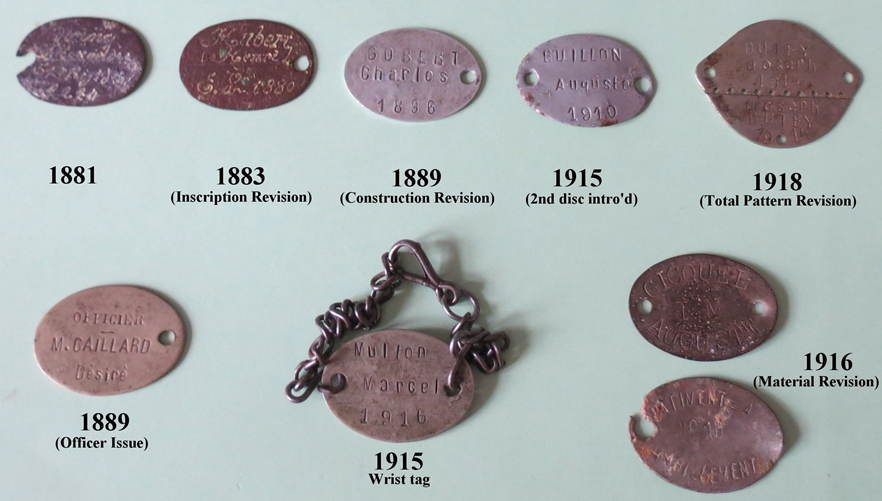 |
|
France |
|
After the rebirth of the French Army following their defeat in the Franco-German War of 1870/71 much in-depth investigation was made as regards their performance and experiences. The French medical services noted, with comparative tables, the numbers of missing and unidentified dead from the French Army as compared with those of the German Army during this conflict. Though the figures were still high, percentage wise, it was possible to see the improvement in post-death identifications that was to be seen in the German armies when compared to those of the French. For this reason, it was decided to introduce an officially issued identity disc to the French Army also. This issue became official from October 21st 1881 (following on from the proposal of 2nd September) when a single metal disc was issued designed to worn, on a cord, around the neck (under the tunic, but over the shirt according to instructions). The French Modele 1881 tag was a small aluminium or steel oval approximately 3cm by 2cm in size with one hole for attachment of the neck cord. Information stamped upon the disc included (on the obverse) the soldiers surname and first name along with regimental details. The reverse was initially blank, but would later contain details of any transfers between units. However, in October 1883, these details were simplified and, from then on, the obverse would be stamped with the soldier's surname and first name along with his “class” year (ie.the year in which he became eligible for compulsory military service) or, in the case of volunteers ,the year of his voluntary enlistment preceded by the letters ‘E.V’ (Engages Voluntaires). On the reverse was to be found his military district (as related to place of birth, not necessarily that of residence) and his service number at recruitment. No further details would be stamped on the disc throughout the soldier's service. On 14th May 1915, due to the post-death identification problems previously discussed, the French Ministry of War ordered the official issue of a second identity disc. This second disc was identical to the first, but had two cord holes to facilitate it being worn as a bracelet on the wrist. Some soldiers strung it with the first disc (as in the post-1916 British style) and others pinned it to the clothing – usually either on the inside of the tunic or on the trousers in the area of the belt. Occasionally, the second disc issue was identical in all ways to the first (one hole) and can be found being worn on a second neck cord. (Though a directive of November 1916 insisted on some form of regimentation in wear and suggested that both discs should be worn on a single neck cord) |
|
Another problem was still being encountered with these discs however. The (mainly) aluminium discs were found to corrode easily and quickly after burial and so, on 27th April 1916, maillechort (a zinc and copper alloy) discs of identical detail to the aluminium discs became available in an attempt to counter this problem. Though the Mle.1881 soldiered on for the remainder of the war and beyond, a new pattern disc was introduced in May 1918 and officially authorized on 12th July 1918. This Mle.1918 took in the advantages of the German 1916 pattern disc in that it had a perforated line so that one part could be removed for records, leaving the remainder to identify the corpse, but only utilising one disc. The information stamped onto the disc was repeated on both halves and was the same as that to be found on the Mle.1881. The Mle.1881, in some cases, also continued to be worn in conjunction with this new disc even though it was intended to replace it for all front-line troops by the late summer of 1918. Measuring 4cm by 3cm, these discs can be encountered manufactured out of aluminium, maillechort, steel and even silver. Intended to be worn on the wrist, they were quite often also worn around the neck. An extremely successful design, it was copied throughout the world and, though officially replaced in circa 1954, was still on issue to French forces as late as the 1960’s |
|
Mle 1881 blanks were encountered in, and adopted by, several armies, making it the most widespread of all the WW1 tags. Other nations who used French pattern tags were… |
|
• Serbia (used 1881 pattern after 1915) • Belgium (1881 pattern after 1915) • Czechoslovakia (Mle 1881 in use with the Czech Legion) • Poland ( mle.1918 between1918-1920) • Greece (mle 1881) • Siam (mle.1881 from July 1918) |
|
The USA, UK, Italy and Portugal all also commonly adopted the Mle.1881 style as unofficial “private purchase” tags. |
|
Belgian Though they had not really experienced personally the need for the issue of an identity disc, the Belgian military closely studied France’s experiences in and following the 1870-71 War and could see their uses. For this reason the Belgian Army, in 1891, issued it’s first identity tag. Following on from the first notification in La Journal Militaire Officiel published on 14th December 1891, this first tag was constructed of ‘white bone’, rectangular in shape and with etched details and a single cord hole. In 1899, following a Belgian Army study of French discs in 1898, a more permanent pattern of identity disc was decided upon which, though not identical, closely resembled that of the French. Of similar dimensions (though it was slightly elongated for the cord attachment) and construction to the French Mle.1881, the Belgian Mle.1899 contained the same information with the exception of “class year”. The Mle.1899 also included the soldier’s regimental detail which was, by now, omitted on French discs. This new pattern disc had totally replaced the bone Model 1891 disc by 1900. After the major part of Belgium, including practically all of the industrial centres, was over-run by the Germans in 1914, the remains of the Belgian Army became much reliant on its allies for aid in clothing and equipping its troops. This also included a need for identity discs from allied nations. There were some (rare) issues of the British 1914 discs, but this was miniscule when compared with the amount of Mle.1881 discs supplied by the French. So many were supplied from 1915 onwards that the French disc became officially designated the Mle.1915 when in Belgian Army use. It was with this French disc (containing the same information as the Mle.1889) that the Belgian Army fought much of (and ended) the war. Some troops in 1918 were also in receipt of the French Mle.1918 disc which was copied by the Belgian Army at the very end of the war and, with slight design changes, became the official Belgian Mle.1918 which was worn into World War 2. (As a point of interest, the French naval pattern disc of the Second World War period resembled the Belgian Mle.1918 disc more than it did the French Mle.1918) |
|
|
|
Austria-Hungary : 'Legitimationsblattkapsel' The first identification method adopted by the Austro-Hungarian army dated back to November 1876 with the adoption of an identity card (‘Legitimationsblatt’) and adopted a protective locket for this identification (the ‘Legitimationsblattkapsel’) in 1902. This consisted of a brass rectangular locket 5cm by 3cm in size that was designed to be sewn or clipped by a loop inside the trouser pocket. Inside the locket was carried the paper identity card (in German for KuK troops and in Hungarian for those of the Honved. Details on this paper included regimental details, class year, personal details such as home town, birth year, religion, place of enlistment and medical records such details of inoculations and wounds, etc. In short, a miniature version of the soldier’s whole attestation record was carried by him at all times. Originally a singly folded sheet of paper, this was doubled in size in 1916 to contain further information relevant in wartime. Due to a wartime shortage of brass, a zinc version was encountered from 1915. This was sealed by a clip and can also, along with the paper insert, include basic details stamped to the case (possibly in an attempt to continue the chance of identification even after the paperwork has become water/decay damaged post-burial. A final version was made in 1918. This was a much simplified version made of a single piece of cheap pressed tin. This had to be tied at the loop to keep it shut. Due to its frailty, not many examples of these survive today. |
|
Italy |
|
Upon their entry into the war in 1915, the Italian Army was one of the few major European armies that had never considered any permanent form of identity disc as a separately worn means of identification for its soldiers. Prior to, and at the time of the outbreak of war (since the publication of circolare n° 207 del Giornale Militare Ufficiale (Circular No. 207 of the Military Official Journal) on 5th November 1892), every Italian soldier carried - sewn onto the inside back cover of his Libretto Personale (paybook) - a small rectangular piece of zinc (similar to that issued to Serbian troops) –measuring approx. 55 X 35 mm - upon which his name, number, class year (year of birth) and place of birth was written in indelible ink. Shortly after the declaration of war, however, the Italians saw the need to rectify this deficiency and, so, immediately began looking for ideas. Their nearest neighbours (and enemy!) Austria gave them the idea that they needed and so the officially issued Italian identity tag was a direct copy of the Austrian locket. (Though the 1892 model piastrino di riconoscimento continued to be issued ). The Italian locket was slightly smaller than that of Austria. Measuring 4cm by 3cm, this locket was made of pressed steel coated and polished with a mirror-like finish on the inside (to double as a mirror for everyday use and signalling). An elongated paper slip was folded up inside, again (like the Austrian version) carrying a highly condensed version of the soldier’s entire attestation record. |
|
Russia |
|
Although it is widespread assumption that the identification of the Russian dead was a very low priority for the Tzarist military, this was only really true after the outbreak of hostilities in 1914 and the huge expansion of the newly mobilized force (which caused some 75% of Russian troops to enter the field with no form of personal identification). As far back as 1902, it had become procedure for some form of identification marker to be issued, on a regimental level, to all soldiers. This regimental issue was self-funded and therefore the designs vary enormously (some regiments, it must be said, didn’t bother with any issue at all) but, in 1909 an army-wide issue was put forward.
The tag of 1909 took the guise of a wooden phial that was designed to contain a slip of paper detailing the soldier to whom it was issued. Supposedly carried in a pocket it was, perhaps, unfortunate that, to the mainly illiterate soldiers, they appeared better suited for carrying matches than they did for personal identification! (a problem that was made more severe in World War 2 when these phials were made of a sealed, screw-top bakelite which made them even more waterproof!). A further pattern tag was issued (to some!) as from 16th January 1917. This took the form of a pressed steel locket and was of similar dimension and detail to the Austrian tags. These lockets could also be encountered regimentally marked.
The Russian soldiers serving in France, however, were better catered for, receiving the Mle.1881 discs of their host army. |
|
|
|
USA The USA would have been the first nation to have officially adopted Identity Discs back in 1862 if the motion hadn’t been rejected. US troops therefore, like most of their European counterparts, had either no identification (other than in paper form) or supplied their own (“Private purchase” tags from the Civil War, China Expedition and Spanish-American war appeared in abundance). The first moves towards the adoption of an official identification disc since the Civil War occurred in 1899 when a Captain Charles C.Pierce of the US Army Quartermaster Corps suggested the inclusion of an ‘identity disc’ in every soldier’s equipment. However, it wasn’t until 20th December 1906 that the War Department General Order number 204 officially sanctioned the first authorised US identity disc. This disc was a small circular aluminium disc, 3cm in diameter, which contained the soldier’s name, rank, unit and the letters “USA” (“United States Army”). It was worn around the neck on a thin bandage-like cotton ribbon. In 1910 a tag was issued that was identical to the 1906 pattern in all ways except size. The 1910 tag measured 3.5 cm in diameter. Both 1906 and 1910 pattern tags were, from now on issued in similar numbers and can be encountered relatively equally. There was one more change before the USA entered the war. Possibly due to reports from the nations already involved in the war or possibly due to experiences in Mexico, a second disc was introduced on 6th July 1916. From now on, the first disc (be it of 1906 or 1910 pattern) had two holes to facilitate the attachment of the second disc. The US Navy introduced its own disc on 12th May 1917 (Naval Dept. General Order Nr 294) soon after the US declaration of war. This disc, constructed of monel metal (the same as ships propellers) and measuring 3.5cm by 3cm, detailed the sailor’s name, date of birth, general function (“USN”, “USNR”, “USMC”, etc) and date of enlistment/engagement. On the rear was featured an impression of his thumb print. All this detail was acid etched into place rather than stamped. With the formation and expansion of the National Army, official pattern discs were becoming in short supply. On 13th August 1917 it was, therefore, necessary to introduce a more quickly manufactured disc to keep up with demand until the machinery used to make the standard patterns could catch up with demand. This 1917 pattern Emergency disc was 3cm square and had a single cord hole. Detail was similar to that of the standard issues. Issues of this pattern dwindled into 1918 as the supply of standard discs caught up with demand. Issue discs remained pretty much unaltered for the rest of the war but there was a couple of changes to detail...On 12th February 1918 serial numbers were introduced so, from then on, these were to be stamped on the rear of the discs and , in July 1918 unit details were to be omitted from discs. Orders were distributed at this time for discs that had units already detailed on them to be destroyed and replaced or to have the details blanked (or “X’d”) out. In reality, this only happened on a large scale in combatant units. The same month also saw the soldier’s religion appearing on discs (at personal choice). The US Marine Corps received either the Naval or Army discs dependant on their particular role. Initially, however, they were in receipt of just the Navy pattern but, following on from General Order Nr. 32 of October 6th 1917, the ‘army pattern’ was also issued. U.S.M.C. (Army) discs utilised the Naval practice of including the Marine’s enlistment/engagement dates. Unit designation (‘U.S.M.C.’ , ‘U.S.M.C.R.’ etc.) was machine stamped prior to issue on US issued discs. However, hand stamped designations can also be encountered. These were likely to have been issued in France. Like the army, serial numbers appeared on U.S.M.C. discs from February 1918. U.S.M.C. (Naval) discs were as per the U.S. Navy. |
|
Miscellaneous Nations |
|
Japan -( 認識票 - Ninshikihyo) |
|
• Adopted ID Tags in 1894 just after the ‘Prussianisation’ of Japanese forces • Brass Oval 4.5cm by 3cm in size designed to be carried on a tape worn diagonally across the body. • Pattern remained unchanged until after 1945. |
|
Turkey |
|
No official identity tag issued until the adoption of the German patterns (though regimentally issued tags - usually (very) loosely based on the German 1869 pattern tag (in construction rather than shape and detail) - do exist). The German 1915 pattern is most commonly encountered, but 1878 (usually of a round (possibly rejected?) pattern) and (more rarely) 1916’s can also be found. Thanks to an article in The Illustrated War News in 1916, a modern misconception has been that Turkish brass “signature seals” were actually used as an identity tag. |
|
Bulgaria |
|
As above. German M1915s being most common. |
|
Serbia |
|
A thin metal plate of similar dimensions to the Italian plaque sewn into the tunic until the adoption of the French mle 1881. |
|
China (CLC) |
|
An irremovable steel bracelet upon which was engraved the labourer’s number was riveted around his wrist. |
|
Portugal |
|
Tags similar to French Mle 1881 and/or British patterns issued. Occasionally tags similar to British “No.2” disc were encountered…quite often made of wood! |
|
Religious denominations found on British and US Identification Discs |
|
B………………..Baptist Bapt…………….Baptist (variant) Bap…………….Baptist (variant) Cath…………….Catholic C….…………….Catholic (variant) CE ……………..Church of England CoE…………….Church of England (variant) CofE……………Church of England (variant) CI………………Church of Ireland CoI……………..Church of Ireland (variant) CofI…………….Church of Ireland (variant) Cong……………Congregationalist CS……………...Church of Scotland CoS…………….Church of Scotland (variant) CofS……………Church of Scotland (variant) E………………..Evangelicalist (variant) Evan……………Evangelicalist Ev………………Evangelicalist (variant) H…………….….Hebrew (Jewish) – US discs only (?) Heb………….….Hebrew (Jewish) - variant J…………………Jewish Jew…………...…Jewish (variant) Meth.....................Methodist M..........................Methodist (variant) - US discs only? NC………………Non-Conformist - US and Canadian discs only? P………………...Protestant - US ,Canadian and S.African discs only? Prot……………...Protestant - US and Canadian discs only? Pres……………...Presbyterian P............................Presbyterian (variant) - GB discs only Q……………......Quaker RC………………Roman Catholic U……………...…Unitarianist W………………..Wesleyan Wes……………...Wesleyan (variant) |
|
German Tag cord colour scheme |
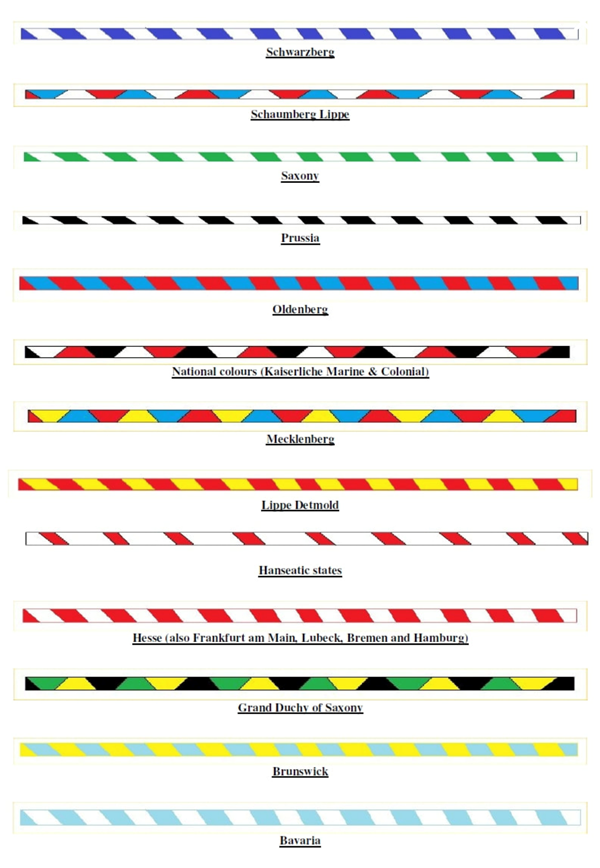 |
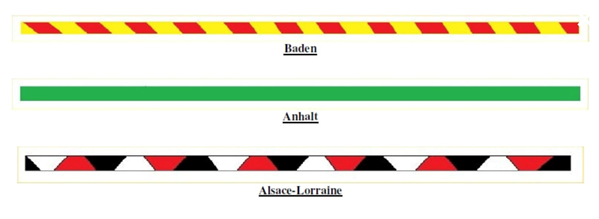 |
 |
| Published 1 May 2020 David O'Mara |






